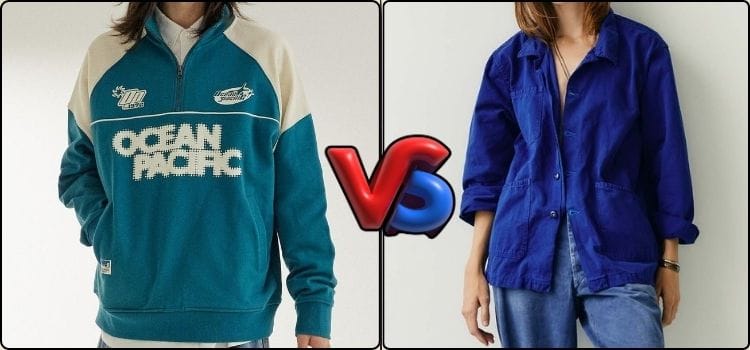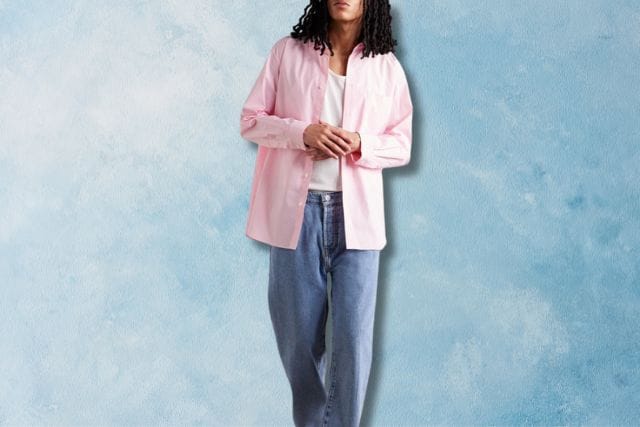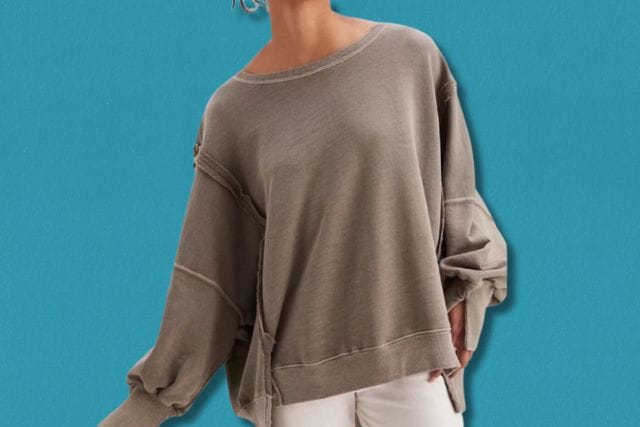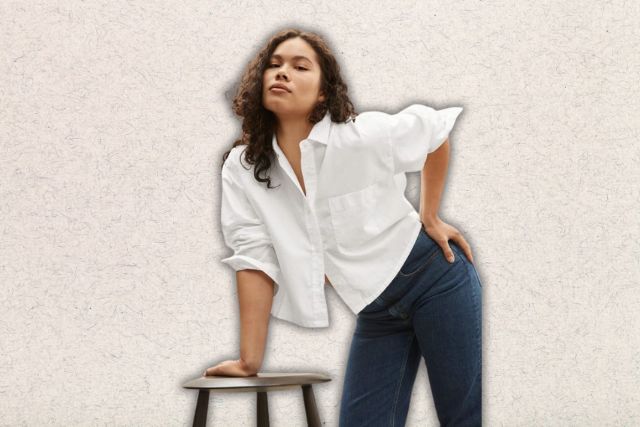Sweatshirt vs Long Sleeve Shirt: Which is Best for You?

As an Amazon Associate, I earn from qualifying purchases
The debate between sweatshirt vs long sleeve shirt continues to captivate fashion enthusiasts. Both of these wardrobe staples offer distinct advantages and cater to different style preferences and needs. They’re layering heroes, perfect for those in-between weather days, and comfy companions for lounging at home. But when it comes to choosing between these two titans of casual wear, things can get a little tricky.
Fear not. This guide will break down the key differences between sweatshirts and long sleeve shirts. It will help you pick the perfect match for your needs and the ever-changing weather.
What is a Sweatshirt?
The sweatshirt, a garment synonymous with comfort and casual cool, boasts a surprisingly recent history. It all began in the 1920s on the football fields of Alabama. Benjamin Russell Jr., tired of the itchy wool jerseys worn by his team, teamed up with his father, a clothing manufacturer, to create a better option. Their solution? A thick cotton practice jersey, the precursor to the modern sweatshirt.

These early sweatshirts were simple, collarless, and oversized. But their functionality was undeniable. They provided warmth during chilly practices while absorbing sweat, making them a big hit with athletes. Fast forward to the 1950s, and the sweatshirt experienced a major upgrade. The invention of polyester blends introduced a more durable and wrinkle-resistant version. This opened the door for the sweatshirt to transition beyond the realm of athletics.
The 1960s saw the rise of college pride, and universities began printing their logos on sweatshirts. This transformed the sweatshirt into a symbol of school spirit, a trend that continues to this day. The 1970s saw the birth of the iconic “hoodie,” a sweatshirt with a hood, adding another layer of functionality and style.
What is a Long Sleeve Shirt?
The long sleeve shirt, a cornerstone of any wardrobe, boasts a history that stretches back centuries. Its exact origins are unclear, but evidence suggests long-sleeved garments were worn as early as ancient civilizations, providing warmth and protection.

Over time, the long sleeve shirt evolved from a practical necessity to a fashion statement. By the Middle Ages, elaborate embroidery and embellishments adorned long sleeves, signifying wealth and social status. The Industrial Revolution brought about mass production, making long sleeve shirts more accessible to the general public. In the 19th and early 20th centuries, long sleeves became a standard part of men’s and women’s attire.
The rise of casual wear in the mid-20th century saw the long sleeve shirt transform into a versatile garment. Today, they come in a vast array of fabrics, from lightweight cotton to thermal options, and styles, from classic button-downs to trendy graphic tees.
Sweatshirt vs Long Sleeve Shirt
The Debate Sweatshirt vs Long Sleeve Shirt can make a big difference. Both options offer their own unique benefits, and understanding the distinctions can help you make the right choice for any occasion.
The Fabric Face-Off
The first battleground is material. Sweatshirts typically come in two main fabric factions: fleece and heavyweight cotton. Fleece is the ultimate champion of warmth. It’s that soft, fuzzy material that feels like a hug from a teddy bear. Heavyweight cotton, on the other hand, is a more breathable option, offering a touch of warmth without feeling stuffy.

Long sleeve shirts, however, are all about versatility. They come in a vast array of fabrics, from lightweight cotton ideal for layering under a jacket, to thermal options for added warmth. Think of them as the shapeshifters of the clothing world, adapting to your temperature needs.
Warmth Factor
This is where things get interesting. Sweatshirts are the undisputed kings (or queens) of warmth. Their thick fabric makes them perfect for those crisp fall mornings or chilly evenings. They’re like a personal portable heater, keeping you toasty without the bulk of a winter coat.
Long sleeve shirts, however, are the layering masters. They provide a light to moderate layer of warmth, making them ideal for adding an extra bit of comfort under jackets, vests, or even cardigans. Think of them as the ultimate base layer for creating cozy outfit combinations.
Style Showdown
Let’s be honest, sweatshirts are the kings (and queens) of casual cool. They pair perfectly with jeans, joggers, or leggings, creating a relaxed and effortless look. Picture yourself running errands on a Saturday morning, a cup of coffee in hand, feeling comfy and put-together in your favorite sweatshirt.
Long sleeve shirts, however, offer a surprising amount of style versatility. They can be dressed up with a blazer or a skirt for a more polished look or dressed down with jeans and sneakers for a casual vibe. They’re the ultimate chameleons, adapting to your mood and the occasion.
The Comfort Corner
This is a close call. Sweatshirts, with their soft fleece or plush cotton, are undeniable cuddle champions. They’re the perfect choice for movie nights on the couch or lazy Sundays spent reading a book.

Long sleeve shirts, however, can be surprisingly comfortable too. They are made from breathable fabrics like cotton or thermals and offer a more relaxed fit than a traditional t-shirt. This makes them ideal for lounging around the house without feeling restricted.
The Verdict: It’s All About Your Needs!
So, who wins the Sweatshirt vs Long Sleeve Shirt battle? The truth is, there is no clear winner. It all depends on your individual needs and preferences.
Here’s a quick cheat sheet to help you decide:
Maintenance and Care
Taking proper care of your clothes extends their lifespan and keeps them looking their best. Here’s how to maintain the coziness of your sweatshirt and long-sleeve shirt:
Sweatshirt
- Washing: Turn inside out and wash on a cold or gentle cycle to prevent shrinkage and fading. Opt for a mild detergent and avoid using fabric softener, which can damage the fleece.
- Drying: Skip the high heat! Tumble dry on low or lay flat to air dry and preserve the softness of the fleece.
- Pilling: Over time, sweatshirts can develop little fabric balls called pilling. Use a fabric shaver to remove them gently.
Long Sleeve Shirt
- Washing: Follow the care instructions on the label. Generally, lightweight cotton shirts can be washed with cold water and similar colors. Button-downs might require a delicate cycle.
- Drying: For most long sleeves, low-heat tumble drying is okay. However, delicate fabrics or those prone to wrinkles might benefit from air drying.
- Ironing: Button-downs and some other long sleeves might require ironing to maintain a crisp look.
Conclusion
Sweatshirt vs Long Sleeve Shirt Both have their unique advantages and can be essential components of any wardrobe. Choosing between them depends on the occasion, the weather, and your personal style preferences. Sweatshirts offer unparalleled comfort and warmth, making them ideal for casual, cold-weather wear. Long sleeve shirts provide versatility and can be dressed up or down, suitable for a wider range of occasions.
FAQ
Technically, a sweatshirt can be considered a type of shirt. It has sleeves and a body that covers the torso, similar to a traditional shirt. However, sweatshirts are typically thicker and more casual than most shirts.
The purpose of a long-sleeved shirt is to provide more coverage and protection compared to a short-sleeved shirt. Long-sleeved shirts can offer warmth in cooler weather, protect the skin from sun exposure, and can be part of professional or formal attire.
People wear long-sleeved shirts in hot weather for several reasons. Long sleeves can protect the skin from harmful UV rays, reducing the risk of sunburn and skin damage.
Yes, sweatshirts are often meant to be worn over shirts. They are designed to provide an additional layer of warmth and can be easily layered with other clothing items. Wearing a sweatshirt over a shirt can enhance comfort, allow for easy temperature regulation, and add to the overall style of an outfit.
As an Amazon Associate, I earn from qualifying purchases

